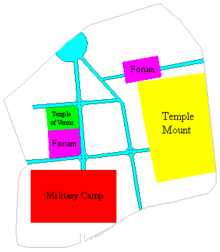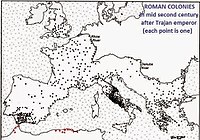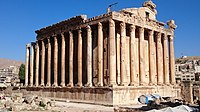Aelia Capitolina
| Aelia Capitolina (Jerusalem) | |||
|---|---|---|---|
| 130 CE – 324-325 CE | |||
 Jerusalem in the Roman empire under Hadrian showing the location of the Roman legions | |||
Chronology
| |||
| Part of a series on |
| Jerusalem |
|---|
 |
Aelia Capitolina (/ˈiːliə ˌkæp[invalid input: 'ɨ']təˈlaɪnə/; Latin in full: COLONIA ÆLIA CAPITOLINA) was a Roman colony, built under the emperor Hadrian on the site of Jerusalem, which was in ruins since the siege of 70 AD,[1] leading in part to the Bar Kokhba revolt of 132–136 AD. Aelia Capitolina remained the official name of Jerusalem until 638 AD when the Arabs conquered the city and kept the first part of it as 'إلياء' (Iliyā').[2]
Foundation
Jerusalem, once heavily rebuilt by Herod, was still in ruins following the decisive siege of the First Jewish–Roman War in 70 AD. Josephus – a contemporary historian and apologist for Judaism who was born in Jerusalem and fought the Romans in that war – reports that "Jerusalem ... was so thoroughly razed to the ground by those that demolished it to its foundations, that nothing was left that could ever persuade visitors that it had once been a place of habitation."[3]
When the Roman Emperor Hadrian vowed to rebuild Jerusalem from the wreckage in 130 AD, he considered reconstructing Jerusalem as a gift to the Jewish people. The Jews awaited with hope, but then after Hadrian visited Jerusalem, he was told that rebuilding the Second Temple would encourage sedition.[4] He then decided to rebuild the city as a Roman colony which would be inhabited by his legionaries.[5][page needed] Hadrian's new plans included temples to the major regional deities, and certain Roman gods, in particular Jupiter Capitolinus.[citation needed]
The Jewish Bar Kokhba revolt, which took the Romans three years to suppress, enraged Hadrian, and he became determined to erase Judaism from the province. Circumcision was forbidden, Iudaea province was renamed Syria Palaestina and Jews expelled from the city.
Indeed, following the Bar Kokhba revolt, Emperor Hadrian combined Iudaea Province with neighboring provinces under the new name of Syria Palaestina, dispensing with the name of Judea.[6] The city was renamed "Aelia Capitolina",[7] and rebuilt it in the style of a typical Roman town. Jews were prohibited from entering the city on pain of death, except for one day each year, during the holiday of Tisha B'Av. Taken together, these measures[8][9][10] (which also affected Jewish Christians)[11] essentially "secularized" the city.[12] The ban was maintained until the 7th century,[13] though Christians would soon be granted an exemption: during the 4th century, the Roman Emperor Constantine I ordered the construction of Christian holy sites in the city, including the Church of the Holy Sepulchre. Burial remains from the Byzantine period are exclusively Christian, suggesting that the population of Jerusalem in Byzantine times probably consisted only of Christians.[14]
Till the time of Constantine, and for at least two centuries later, Aelia remained the official name and usual geographical designation ; was still longer continued in Christian writings; and even passed over into Arabic as "Iliyā" [15]
In the fifth century, the eastern continuation of the Roman Empire that was ruled from the recently renamed Constantinople, maintained control of the city. Within the span of a few decades, the city shifted from Byzantine to Persian rule, then back to Roman-Byzantine dominion. Following Sassanid Khosrau II's early seventh century push through Syria, his generals Shahrbaraz and Shahin attacked Jerusalem (Template:Lang-fa) aided by the Jews of Palaestina Prima, who had risen up against the Byzantines.[16]
In the Siege of Jerusalem of 614 AD, after 21 days of relentless siege warfare, Jerusalem was captured. Byzantine chronicles relate that the Sassanids and Jews slaughtered tens of thousands of Christians in the city, many at the Mamilla Pool, and destroyed their monuments and churches, including the Church of the Holy Sepulchre. The conquered city would remain in Sassanid hands for some fifteen years until the Byzantine Emperor Heraclius reconquered it in 629.[17]
Roman Jerusalem reached a peak in size and population at the end of the Second Temple Period, when the city was called "Aelia Capitolina" and covered two square kilometers (0.8 sq mi) and had a population of 200,000.[9][18]

Byzantine Jerusalem was conquered by the Arab armies of Umar ibn al-Khattab in 638 AD.[19] Among Muslims of Islam's earliest era it was referred to as Madinat bayt al-Maqdis ("City of the Temple")[20] which was restricted to the Temple Mount. The rest of the city was called "Iliya", reflecting the Roman name given the city following the destruction of 70 CE: Aelia Capitolina".[21]
Christianity
According to Eusebius, the Jerusalem church was scattered twice, in 70 and 135, with the difference that from 70-130 the bishops of Jerusalem have evidently Jewish names, whereas after 135 the bishops of Aelia Capitolina appear to be Greeks.[22] Eusebius' evidence for continuation of a church at Aelia Capitolina is confirmed by the Bordeaux Pilgrim.[23]
Name
Aelia came from Hadrian's nomen gentile, Aelius, while Capitolina meant that the new city was dedicated to Jupiter Capitolinus, to whom a temple was built on the site of the former Jewish temple, the Temple Mount.[1] The Latin name Aelia is the source of the Arabic term Iliyā' (إلياء), an early Islamic name for Jerusalem.
Plan of the city


The city was without walls, protected by a light garrison of the Tenth Legion, during the Late Roman Period. The detachment at Jerusalem, which apparently encamped all over the city’s western hill, was responsible for preventing Jews from returning to the city. Roman enforcement of this prohibition continued through the 4th century.
The urban plan of Aelia Capitolina was that of a typical Roman town wherein main thoroughfares crisscrossed the urban grid lengthwise and widthwise.[24] The urban grid was based on the usual central north-south road (cardo) and central east-west route (decumanus). However, as the main cardo ran up the western hill, and the Temple Mount blocked the eastward route of the main decumanus, a second pair of main roads was added; the secondary cardo ran down the Tyropoeon Valley, and the secondary decumanus ran just to the north of the Temple Mount. The main Hadrianic cardo terminated not far beyond its junction with the decumanus, where it reached the Roman garrison's encampment, but in the Byzantine era it was extended over the former camp to reach the southern walls of the city.
The two cardines converged near the Damascus Gate, and a semicircular piazza covered the remaining space; in the piazza a columnar monument was constructed, hence the Arabic name for the gate - Bab el-Amud (Gate of the Column). Tetrapylones were constructed at the other junctions between the main roads.
This street pattern has been preserved in the Old City of Jerusalem to the present. The original thoroughfare, flanked by rows of columns and shops, was about 73 feet (22 meters) wide, but buildings have extended onto the streets over the centuries, and the modern lanes replacing the ancient grid are now quite narrow. The substantial remains of the western cardo have now been exposed to view near the junction with Suq el-Bazaar, and remnants of one of the tetrapylones are preserved in the 19th century Franciscan chapel at the junction of the Via Dolorosa and Suq Khan ez-Zeit.
As was standard for new Roman cities, Hadrian placed the city's main Forum at the junction of the main cardo and decumanus, now the location for the (smaller) Muristan. Adjacent to the Forum, at the junction of the same cardo, and the other decumanus, Hadrian built a large temple to Venus, which later became the Church of the Holy Sepulchre; despite 11th century destruction, which resulted in the modern Church having a much smaller footprint, several boundary walls of Hadrian's temple have been found among the archaeological remains beneath the Church.[25] The Struthion Pool lay in the path of the northern decumanus, so Hadrian placed vaulting over it, added a large pavement on top, and turned it into a secondary Forum;[26] the pavement can still be seen under the Convent of the Sisters of Zion.[26]
See also
Notes
- ^ a b Chisholm, Hugh, ed. (1911). . Encyclopædia Britannica. Vol. 1 (11th ed.). Cambridge University Press.
- ^ Map of the early Arab dominions, showing Iliya
- ^ Josephus, Jewish War, 7:1:1
- ^ Midrash Rabba, Genesis Rabba 64 (end)
- ^ Benjamin Isaac, The Near East under Roman Rule: Selected Papers (Leiden: Brill 1998)
- ^ Elizabeth Speller, Following Hadrian: A Second-Century Journey Through the Roman Empire, p. 218, at Google Books, Oxford University Press, 2004, p. 218
- ^ Lehmann, Clayton Miles. "Palestine: People and Places". The On-line Encyclopedia of the Roman Provinces. The University of South Dakota. Archived from the original on 10 March 2008. Retrieved 18 April 2007.
- ^ Peter Schäfer (2003). The Bar Kokhba war reconsidered: new perspectives on the second Jewish revolt against Rome. Mohr Siebeck. pp. 36–. ISBN 978-3-16-148076-8. Retrieved 4 December 2011.
- ^ a b Lehmann, Clayton Miles (22 February 2007). "Palestine: History". The On-line Encyclopedia of the Roman Provinces. The University of South Dakota. Archived from the original on 10 March 2008. Retrieved 18 April 2007.
- ^ Cohen, Shaye J. D. (1996). "Judaism to Mishnah: 135–220 C.E". In Hershel Shanks (ed.). Christianity and Rabbinic Judaism: A Parallel History of their Origins and Early Development. Washington DC: Biblical Archaeology Society. p. 196.
- ^ Emily Jane Hunt, Christianity in the second century: the case of Tatian, p. 7, at Google Books, Psychology Press, 2003, p. 7
- ^ E. Mary Smallwood The Jews under Roman rule: from Pompey to Diocletian : a study in political relations, p. 460, at Google Books BRILL, 1981, p. 460.
- ^ Zank, Michael. "Byzantian Jerusalem". Boston University. Retrieved 1 February 2007.
- ^ Gideon Avni, The Byzantine-Islamic Transition in Palestine: An Archaeological Approach, p. 144, at Google Books, Oxford University Press 2014 p.144.
- ^ Template:PDFlink
- ^ Conybeare, Frederick C. (1910). The Capture of Jerusalem by the Persians in 614 AD. English Historical Review 25. pp. 502–517.
- ^ Rodney Aist,The Christian Topography of Early Islamic Jerusalem,Brepols Publishers, 2009 p.56:'Persian control of Jerusalem lasted from 614 to 629'.
- ^ Har-el, Menashe (1977). This Is Jerusalem. Canaan Publishing House. pp. 68–95. ISBN 0-86628-002-2.
- ^ Dan Bahat (1996). The Illustrated Atlas of Jerusalem. p. 71.
- ^ Ben-Dov, M. Historical Atlas of Jerusalem. Translated by David Louvish. New York: Continuum, 2002, p. 171
- ^ Linquist, J.M., The Temple of Jerusalem, Praeger, London, 2008, p. 184
- ^ "Jerusalem in Early Christian Thought" p75 Explorations in a Christian theology of pilgrimage ed Craig G. Bartholomew, Fred Hughes
- ^ Richard Bauckham "The Christian Community of Aelia Capitolina" in The Book of Acts in Its Palestinian Setting p310.
- ^ The Cardo Hebrew University
- ^ Virgilio Corbo, The Holy Sepulchre of Jerusalem (1981)
- ^ a b Pierre Benoit, The Archaeological Reconstruction of the Antonia Fortress, in Jerusalem Revealed (edited by Yigael Yadin), (1976)
External links
- Detailed description (including map) of the city of Aelia Capitolina
- Pictures of the cave where it is believed by Christians that Jesus was buried and from which it is believed he resurrected and a picture of the remains of the walls of the Temple of Venus previously constructed on that site by the Emperor Hadrian
- "Archaeologists bringing Jerusalem's ancient Roman city back to life" by Nir Hasson, Ha'aretz, February 21, 2012
- Ill-formatted IPAc-en transclusions
- Ancient Jewish history during the Roman Empire
- Bar Kokhba revolt
- Classical sites in Jerusalem
- Former populated places in Southwest Asia
- History of Jerusalem
- Judea (Roman province)
- Nerva–Antonine dynasty
- Populated places established in the 2nd century
- 131 establishments in the Roman Empire
- 320s disestablishments in the Roman Empire
- Roman towns and cities in Israel


